Month: August 2018
Are you Exploring LGBT History with Urban Archive Yet?
20180824
Already in-the-know about Urban Archive? If not, it’s a free mobile app that maps thousands of historical images from the city’s many wonderful libraries, museums, historical societies, and preservation organizations — and that includes the NYC LGBT Historic Sites Project! Working with the Urban Archive team, we’ve shared curated walks in celebration of Pride Month and traced LGBT history on one of their engaging Hunts. If you haven’t already downloaded, we highly recommend you give it a try.
Now’s a great time to start using Urban Archive because just this summer, they rolled out version 1.0 of the mobile app. With updates to navigation, content discovery tools and more, connecting with history through Urban Archive is more enjoyable than ever. Here’s the full story via Medium.
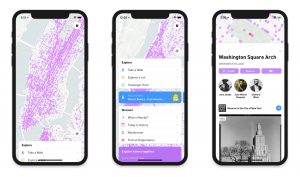
Cultural Landmarks Symposium
October 1, 2018 | 9:00am-3:00pm
Riverside Church
490 Riverside Drive
View on Google Maps
After 30 years of efforts, how do preservationists win greater recognition for New York City’s cultural landmarks?
Join the NYC LGBT Historic Sites Project, Historic Districts Council and the New York Preservation Archive Project on October 1 at a historic Riverside Church for our Cultural Landmarks Symposium.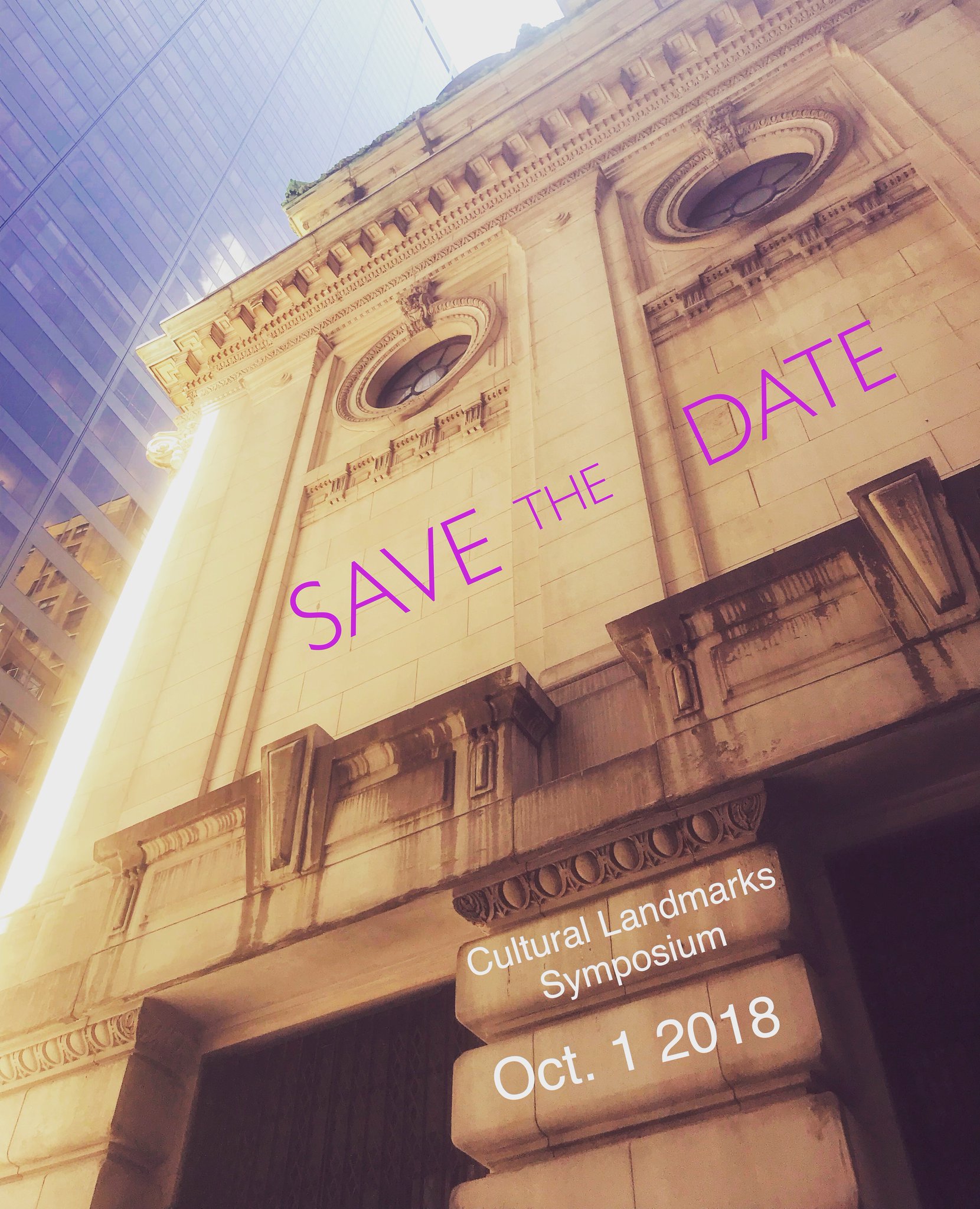
Project Manager Amanda Davis on Bronxnet’s OPEN
August 14, 2018
On Wednesday our very own Amanda Davis joined Daren Jaime on Bronxnet to discuss the Project’s origins and its work documenting LGBT history in all of New York City’s five boroughs, but especially in the Bronx.
Watch for a rundown of some of the Bronx’s most important LGBT sites including Christine Jorgensen’s childhood home, Woodlawn Cemetery and Orchard Beach.
Watch below:
Bronxites and everyone else: Do you have ideas for important Bronx-based LGBT sites to feature on this website? Click here to submit a site!
Gay Green-Wood Tour
October 14, 2018 | 3:30pm-5:30pm
Green-Wood Cemetery
5th Avenue and 25th Street
View on Google Maps
 Green-Wood celebrates LGBT History month with a special trolley tour illuminating permanent residents who have made a lasting impact on American culture in the nineteenth and twentieth centuries. You will visit the graves of important LGBT figures including “It’s Raining Men” co-writer, Paul Jabara; sculptor of Central Park’s Bethesda Fountain, Emma Stebbins; activists and founders of the Hetrick Martin Institute, Drs. Emery Hetrick and Damien Martin, among others. This trolley tour is led by Andrew Dolkart and Ken Lustbader, Co-Directors of the NYC LGBT Historic Sites Project.
Green-Wood celebrates LGBT History month with a special trolley tour illuminating permanent residents who have made a lasting impact on American culture in the nineteenth and twentieth centuries. You will visit the graves of important LGBT figures including “It’s Raining Men” co-writer, Paul Jabara; sculptor of Central Park’s Bethesda Fountain, Emma Stebbins; activists and founders of the Hetrick Martin Institute, Drs. Emery Hetrick and Damien Martin, among others. This trolley tour is led by Andrew Dolkart and Ken Lustbader, Co-Directors of the NYC LGBT Historic Sites Project.
$20 for members of Green-Wood and BHS / $25 for non-members
Green-Wood trolley tours are fully accessible and ADA compliant. In order to accommodate a wheelchair or other mobility device on the trolley, advance arrangements must be made. Please call (718) 210-3080, ext. 1. Please note that portions of the tour take place outside the trolley and may require exiting the vehicle on multiple occasions. Please contact the Historic Fund for more information.
Check-in will take place by the Gothic Arch at our Main Entrance at 5th Avenue and 25th Street. Trolley tours are run rain or shine, with the exception of dangerous conditions as determined by Green-Wood. Click here for our inclement weather policy.
Co-sponsored by
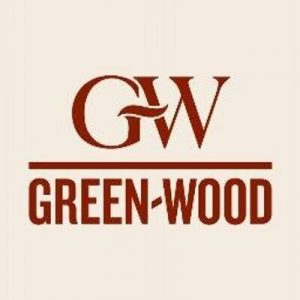
AIDS Activist’s Elmhurst Corner Added To LGBT History Map
August 15, 2018
By: Danielle Woodward


ELMHURST, QUEENS — Locals are reminded of Guillermo Vasquez’s role in LGBT history every time they walk past the Elmhurst street corner bearing his name.
The intersection of 77th Street and Broadway has, for years, been home to the street sign honoring the late Jackson Heights activist who helped organize the first Queens Pride Parade. Now, that corner – and Vasquez’s name – will go from a neighborhood reminder to a historic spot in New York City’s LGBT history.
The NYC LGBT Historic Sites Project’s latest map documenting historic places in the city’s LBTQ history will now include the Guillermo Vasquez Corner in Elmhurst, organizers announced Wednesday. The ever-evolving digital interactive map features places across the city’s five boroughs that have shaped the LGBT community’s history and impact on the city.
Vasquez, a Colombian-born immigrant, came to New York City to study international law and political science and found his lifetime home after in Queens, where he became a leading activist for AIDS, gay rights and the borough’s Latino community.
He was a founding member of the Queens Hispanic Coalition and Queens Gays and Lesbians United, where he pushed for visibility of the LGBT community and raised awareness about the AIDS epidemic. He also advocated for LGBT rites with city and statewide organizations such as the Anti-Violence Project and the Empire State Pride Agenda.
But Vasquez is perhaps most remembered for his role in organizing the first Queens Pride Parade in 1993 and serving as a translator for Spanish-speaking participants. The LGBT parade, which began as a vigil for Julio Rivera after the 29-year-old was murdered for being gay, is now recognized as the second largest in the city with upwards of 40,000 attendees each year.
Vasquez, who died of AIDS-related complications in 1996, was recognized for his work years later by local leaders, who co-named the intersection of 77th Street and Broadway in his honor in 2013. The corner was right outside Love Boat, a former Latino bar where Vasquez educated the community about HIV/AIDS.
“If it wasn’t for Julio, the Queens LGBT movement would not have gotten as far as it has gotten,” said Queens City Councilman Daniel Dromm.
“Julio did not die in vain. He changed people’s lives.”
A spokesperson for the LGBT Historic Sites Project said at a time where historic spots across NYC are being demolished, it’s important for the group to honor early activists like Vasquez who carved out the community’s space in the city.
“It is more important than ever to remember the determination of LGBT equal rights pioneers and the physical sites which place key people and events in history,” the group said in a statement.
Vasquez’s street corner marks the ninth Queens site on the digital interactive map, but organizers said several more in the borough are being vetted for publication in the late summer and early fall.
Other Queens sites on the historic map include:
- Bum Bum Bar in Woodside
- West Side Tennis Club in Forest Hills
- Frank Kameny Residence in South Richmond Hill
- Kitty Genovese Residence in Kew Gardens
- Julio Rivera Corner in Jackson Heights
- New York State Pavilion in Corona
- Riis Park Beach in the Rockaways
- Manford Family Residence in Murray Hill
Image: NYC Council Member Daniel Dromm and Nayibe Nunez-Berger, president of the Latin American Cultural Center of Queens, hold the Guillermo Vasquez Corner sign at the street co-naming ceremony. Photo by Ana Luisa Castaño/Queens Latino via the NYC LGBT Historic Sites Project
Click here to read the full article at Patch.
Click here to read the full article on QNS.com
Elmhurst corner co-named for Latino activist added to interactive map of historic LGBT sites
20180814
By: Emily Davenport
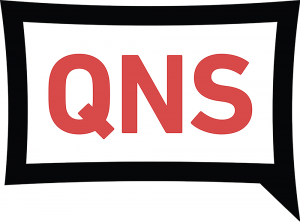

NYC Councilman Daniel Dromm and Nayibe Nunez-Berger, president of the Latin American Cultural Center of Queens, hold the Guillermo Vasquez Corner sign at the July 27, 2013, street co-naming ceremony.
An Elmhurst corner co-named for a Colombian-born Queens resident who helped organize annual Queens Pride Parade has been added to a digital map of historic LGBT spots in New York City.
The NYC LGBT Historic Sites Project announced that it has added Guillermo Vasquez Corner, located at the corner of 77th Street and Broadway, has been added to their interactive map. The map features diverse places from the 17th century to the year 2000 that are important to local LGBT history.
Born near Cali, Columbia, Guillermo Vasquez emigrated to Queens in 1972 to study international law. A longtime resident of Jackson Heights, Vasquez was a key advocate for the borough’s Latino community and pushed for LGBT visibility in Queens. He also raised awareness about the AIDS epidemic, particularly in the Latino community.
A member of Queens Gays and Lesbians United, Vasquez would go on to serve on the board of the Empire State Pride Agenda, a statewide organization that advocated for LGBT rights. In 1993, he helped organize the first Queens Pride Parade as a member of the Queens Lesbian and Gay Pride Committee and served as a translator for Spanish-speaking participants. Vasquez would later pass away due to AIDS-related complications in 1996.
The corner of 77th Street and Broadway was co-named “Guillermo Vasquez Corner” back in 2013. The sign was unveiled next to the Love Boat, a former gay Latino bar where Vasquez educated the community about HIV/AIDS.
“He was a fierce soldier in the battle against HIV/AIDS and a bridge between Latino activists and other movements for social justice.” said NYC Councilman Daniel Dromm at the unveiling.
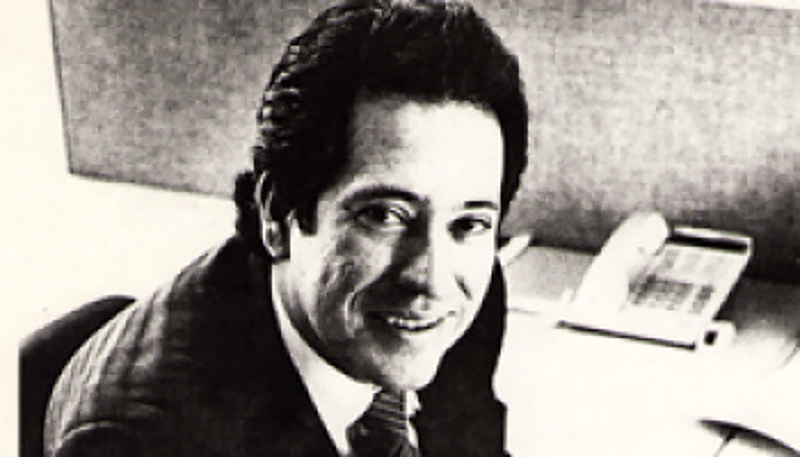
“Guillermo Vasquez Corner” joins eight other historic sites for the LGBT community on the interactive map. The publication of the “Guillermo Vasquez Corner” entry on The NYC LGBT Historic Sites Project’s website comes just days before the 18th anniversary of the silent candlelight vigil for Julio Rivera that took place in Jackson Heights on Aug. 18, 1990.
Rivera, a 29-year-old Puerto Rican man from the Bronx, was brutally attacked by three skinheads from a local street gang in the P.S. 69 schoolyard because he was gay. Rivera later died of his injuries at Elmhurst Hospital.
The vigil is considered the first successful gay public demonstration in Queens and marked the expansion of LGBT activism beyond Manhattan and connecting activists in both boroughs. In 2013, the southwest corner of 78th Street and 37th Avenue was co-named “Julio Rivera Corner” to honor his memory, and was later added to the interactive map.
“If it wasn’t for Julio, the Queens LGBT movement would not have gotten as far as it has gotten. Julio did not die in vain. He changed people’s lives,” Councilman Daniel Dromm said of Julio Rivera in 2015.
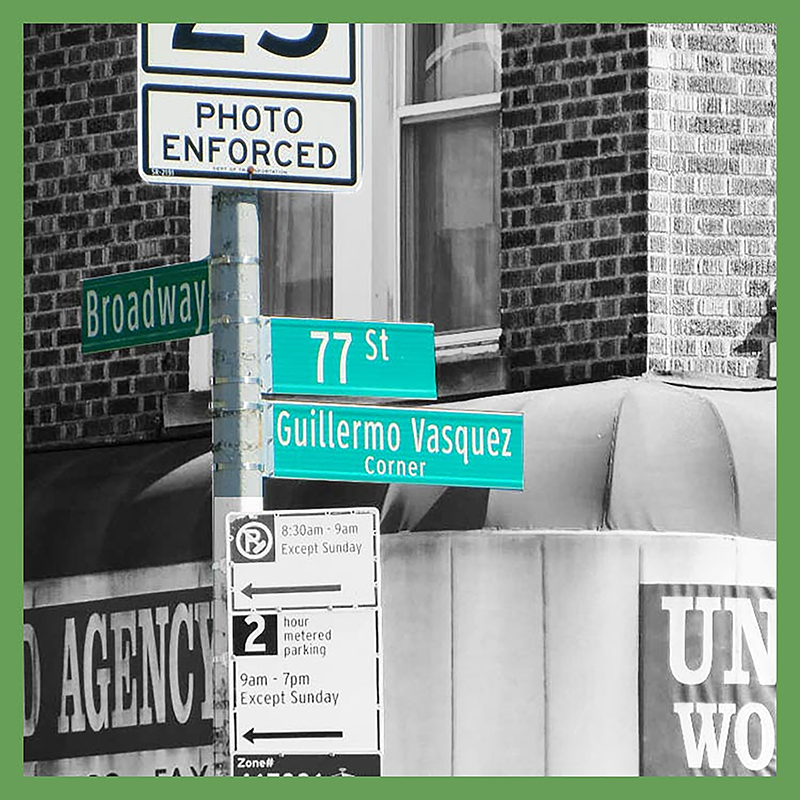
Click here to read the full article on QNS.com
LGBT history mapped as another Queens site is published
20180814
FOR IMMEDIATE RELEASE
PRESS CONTACT
Ken Lustbader, NYC LGBT Historic Sites Project
p: (917) 848-1776 / e: [email protected]
Guillermo Vasquez Corner is latest Queens LGBT
site featured on dynamic digital map
Corner of 77th Street and Broadway, in Elmhurst, honors Colombian-born
Queens resident who helped co-found annual Queens Pride march
New York, NY—The NYC LGBT Historic Sites Project announces the digital publication of its latest Queens-based site significant to the City’s LGBT history: Guillermo Vasquez Corner, in Elmhurst. This latest historic site brings the total of sites in Queens up to nine, with many more in the queue for further research and publication in late Summer/early Fall.
Guillermo Vasquez was a leading gay rights, AIDS, and Latino community activist in Queens who emigrated from Colombia in 1972. Seventeen years after his 1996 death from AIDS-related complications, the corner of 77th Street and Broadway was renamed “Guillermo Vasquez Corner” and a street sign was unveiled next to the site of the Love Boat, a former gay Latino bar where Vasquez educated the community about HIV/AIDS.
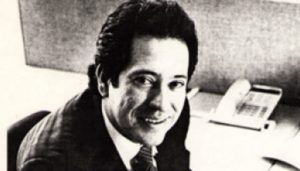
NYC Councilmember Daniel Dromm, Chair of the Council’s LGBT Caucus, recalls of the impact Guillermo Vasquez made on his Queens and Latino communities: “He was a fierce soldier in the battle against HIV/AIDS and a bridge between Latino activists and other movements for social justice.”
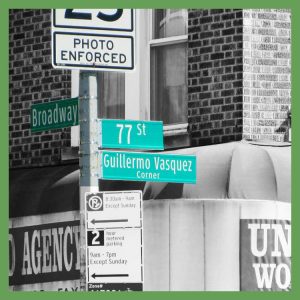
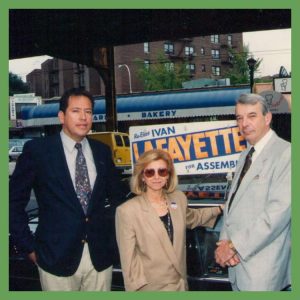
Other significant LGBT sites in Queens already published to the Project’s interactive map include:
- Bum Bum Bar (more)
- West Side Tennis Club (more)
- Frank Kameny Residence (more)
- Kitty Genovese Residence (more)
- Julio Rivera Corner (more)
- New York State Pavilion (more)
- Riis Park Beach (more)
- Manford Family Residence (more)
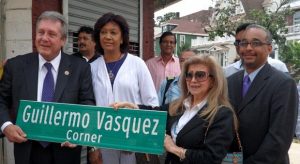 Photos:
Photos:
(1) Guillermo Vasquez.
(2, left) Guillermo Vasquez Corner street sign in front of the building that once housed the Love Boat, a gay Latino bar where Vasquez educated the community about HIV/AIDS, 2018. Photo by Amanda Davis/NYC LGBT Historic Sites Project.
(3, right) Guillermo Vasquez (at left), Nayibe Nunez-Berger and New York State Assembly representative Ivan Lafayette on Roosevelt Avenue in Jackson Heights, c. 1990s. Courtesy of NYC Council Member Daniel Dromm.
(4) NYC Council Member Daniel Dromm and Nayibe Nunez-Berger, president of the Latin American Cultural Center of Queens, hold the Guillermo Vasquez Corner sign at the July 27, 2013 street co-naming ceremony. State Senator José Peralta is at right. Photo by Ana Luisa Castaño, via Queens Latino.
Historical Background
Born near Cali, Colombia, Guillermo Vasquez (1953-1996) immigrated to the United States in 1972 to study international law and political science at Pace and Columbia universities. A long-time resident of Jackson Heights, Queens, Vasquez was a leading advocate for the borough’s Latino community. He was a founding member and president of the Queens Hispanic Coalition, a founding member of the Latin American Cultural Center of Queens, and a member of the Colombian American National Coalition.
Vasquez was also instrumental in pushing for LGBT visibility in Queens and raising awareness—especially among Latinos—about the AIDS epidemic. Vasquez was a member of Queens Gays and Lesbians United (Q-GLU), worked with the New York City Gay and Lesbian Anti-Violence Project (now the Anti-Violence Project), and served on the board of the Empire State Pride Agenda, a statewide organization that advocated for LGBT rights. In 1993, as a member of the Queens Lesbian and Gay Pride Committee, he helped organize the first Queens Pride Parade and served as a translator for Spanish-speaking participants. (more)
As sites connected to LGBT history in NYC are threatened — the former site of the Paradise Garage has been demolished; 69 West 14th Street, site of the founding of the Gay Liberation Front, is actively threatened by the wrecking ball — it is more important than ever to remember the determination of LGBT equal rights pioneers and the physical sites which place key people and events in history.
About the NYC LGBT Historic Sites Project
The NYC LGBT Historic Sites Project is a cultural initiative and educational resource that is documenting historic sites connected to the LGBT community throughout New York City. Its interactive map features diverse places from the 17th century to the year 2000 that are important to LGBT history and illustrate the community’s influence on American culture. The Project is nominating sites to the National Register of Historic Places and developing educational tours and programs.
###
Caffe Cino: Off-Off Broadway and On the National Register
October 23, 2018 | 6:30pm
Judson Memorial Church
239 Thompson Street | Manhattan
View on Google Maps
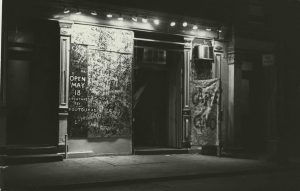
Caffe Cino, May 1965. Photo by James D. Gossage. Courtesy of the New York Public Library, Billy Rose Theatre Division. Ahead of the first anniversary of Caffe Cino’s listing on the National Register of Historic Places, join Caffe Cino historian and veteran Magie Dominic, as well as Amanda Davis, Project Manager at the NYC LGBT Historic Sites Project and author of the National Register nomination, to celebrate and learn about this groundbreaking, pre-Stonewall café theater.
Caffe Cino, located at 31 Cornelia Street from 1958 to 1968, was the creation of Joe Cino, an openly gay Italian-American producer who is credited with starting the “Off-Off-Broadway” theater movement. Caffe Cino was the first important venue to regularly stage Off-Off-Broadway productions, was critical in the development of gay theater, and served as a place of support for gay playwrights during a time when depicting LGBT experiences on stage was illegal.
Co-sponsored by

Three Years of Documenting and Celebrating LGBT Historic Sites
20180801
We’re not too shy to ask: will you please make a donation to celebrate the third anniversary of the Project, and our work to document LGBT sites?
In August 2015, the NYC LGBT Historic Sites Project was established with a mission to document and honor LGBT place-based history in NYC. We’ve made incredible achievements in these first three years, and our work continues to be more essential than ever. We must put LGBT history—often invisible to the public at-large—on the map and document our cultural heritage before it’s too late.
We hope that, in celebration of our birthday, you’ll consider a donation. Please give today.